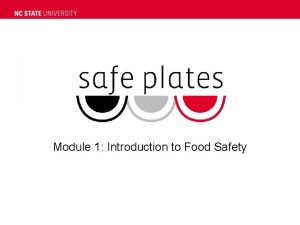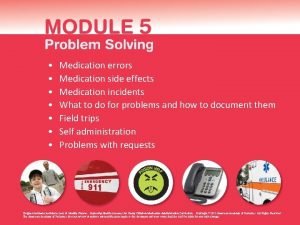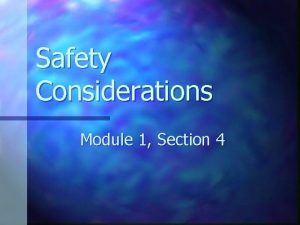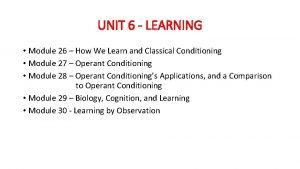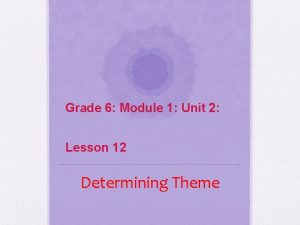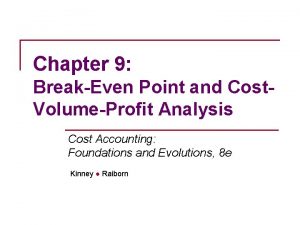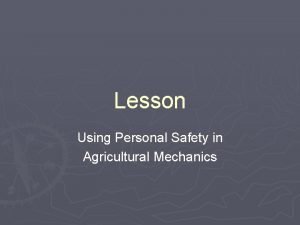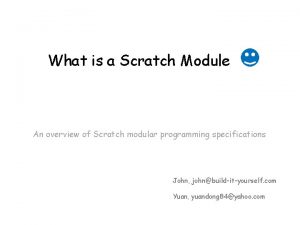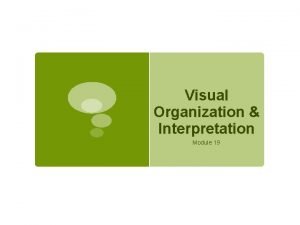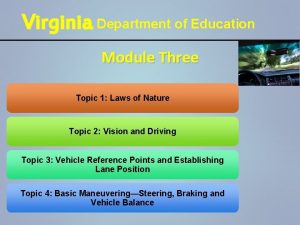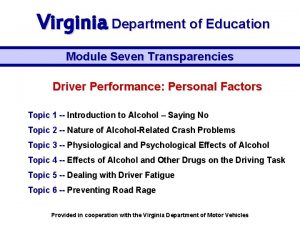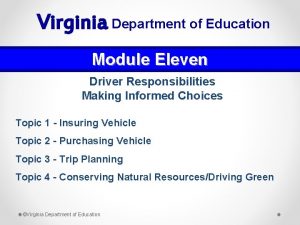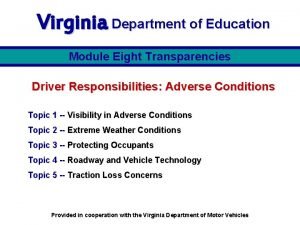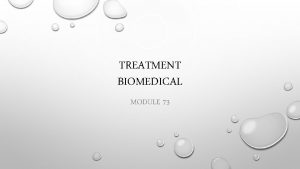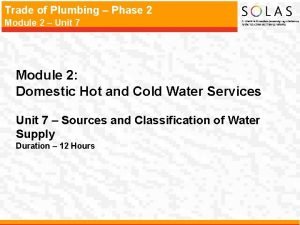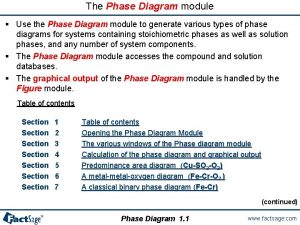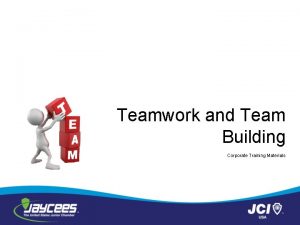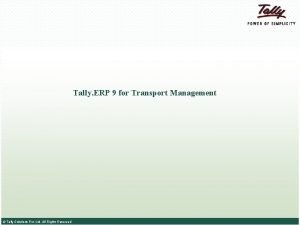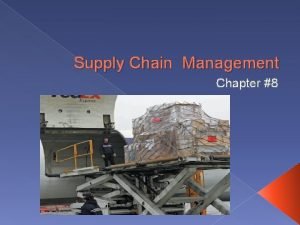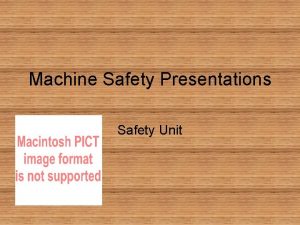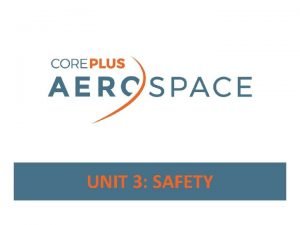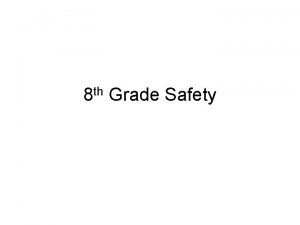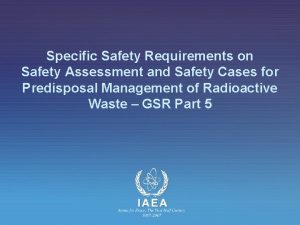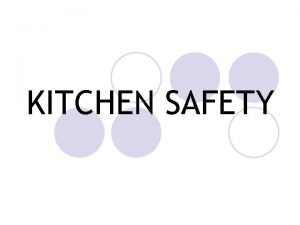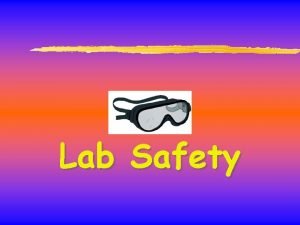Unit 2 Safety Module d 2 1 d


















































- Slides: 50

Unit 2 Safety Module (d) 2. 1 d Identify The Causes Of Accident And Accident Prevention HUMAN CAUSES OF ACCIDENTS CARELESSNESS • A major cause of accidents in workshops is due to the carelessness of the workers. • A high percentage of accidents in workshops are due to carelessness and using the wrong tool. • When you are using the wrong tool for a task, you will tend to apply more force than normal. The excessive force may result in slipping or breaking the tool, both could lead to damaging consequences. Always use the right tool for the job. 1

Unit 2 Safety Module (d) 2. 1 d Identify The Causes Of Accident And Accident Prevention HUMAN CAUSES OF ACCIDENTS IMPROPER BEHAVIOR AND DRESS • There are many causes that can indeed be self injuring or be fatal. The first thing that may be the cause of a workshop accident is wearing the improper equipment. • It is important to wear the proper equipment such as safety goggles, a work mask to keep particles out of your lungs. Having the proper equipment helps you to maintain a safe work environment. • Secondly loose clothing is also a factor in workshop accidents. For example, if you are working near an open flame or near a cutting device, having loose clothing can increase injury. 2

Unit 2 Safety Module (d) 2. 1 d Identify The Causes Of Accident And Accident Prevention HUMAN CAUSES OF ACCIDENTS LACK OF TRAINING • Not having knowledge and training regarding workshop rules is also a cause of accidents in workshops. You must know the rules when working in a workshop. • For example, you must know how to use certain devices. If you do not know then you run the risk of increasing injury. • One final reason is because one does not know the workshop procedures. Knowing what to do and in what order is key. If you do something out of order such as using a device in the wrong sequence, then you risk an injury or a fatality. 3

Unit 2 Safety Module (d) 2. 1 d Identify The Causes Of Accident And Accident Prevention HUMAN CAUSES OF ACCIDENTS SUPERVISION AND EXPERIENCE • Often it is observed that accidents take place when there is no one experienced present in the workshop to supervise the operations. • A close monitoring and supervision of all activities in the workshop is essential to avoid serious accidents. 4

Unit 2 Safety Module (d) 2. 1 d Identify The Causes Of Accident And Accident Prevention HUMAN CAUSES OF ACCIDENTS FATIGUE Fatigue or exhaustion is also a major cause of accidents in the workshop. Make sure workers do not suffer overtiredness due to work as it will make them prone to accidents and injuries. 5

Unit 2 Safety Module (d) 2. 1 d Identify The Causes Of Accident And Accident Prevention HUMAN CAUSES OF ACCIDENTS DRUG TAKING One of the many serious consequences of drug taking and alcohol is causing accidents at workplace. 6

Unit 2 Safety Module (d) 2. 1 d Identify The Causes Of Accident And Accident Prevention ENVIRONMENTAL CAUSES OF ACCIDENTS UNGUARDED OR FAULTY MACHINERY AND TOOLS Accidents are usually caused when workers tend to roam around or operate on unguarded and faulty machinery respectively which may cause serious injury. Whenever a machine or equipment gets out of order, it should be well guarded or a warning sign should be placed nearby to intimate the workers in the workplace. 7

Unit 2 Safety Module (d) 2. 1 d Identify The Causes Of Accident And Accident Prevention ENVIRONMENTAL CAUSES OF ACCIDENTS INADEQUATE VENTILATION Workplaces where fumes or smoke are formed as a result of operation should be properly ventilated so that workers remain safe from the harmful consequences of the fumes which may cause serious damage to the lungs of the workers. 8

Unit 2 Safety Module (d) 2. 1 d Identify The Causes Of Accident And Accident Prevention ENVIRONMENTAL CAUSES OF ACCIDENTS UNTIDY, DIRTY WORKPLACE An untidy workplace means potential accidents. Equipments and tools should be placed properly in a tidy manner so that those who are inside the workshop and those visiting should remain safe from tripping over something which may be harmful or become exposed to potential danger. 9

Unit 2 Safety Module (d) 2. 1 d Identify The Causes Of Accident And Accident Prevention ENVIRONMENTAL CAUSES OF ACCIDENTS OVERCROWDED WORKPLACE A workplace should never be overcrowded. Crowded workplaces expose the workers to danger in a manner that people can get hurt due to the carelessness of their own colleagues. 10

Unit 2 Safety Module (d) 2. 1 d Identify The Causes Of Accident And Accident Prevention ENVIRONMENTAL CAUSES OF ACCIDENTS BADLY-LIT WORKPLACE A lot of accidents take place when workers do not properly recognize the right tool or trip over something due to bad light inside the workshop or workplace. 11

Unit 2 Safety Module (d) 2. 1 d Identify The Causes Of Accident And Accident Prevention PREVENTION ELIMINATE THE HAZARD Care should be taken that all potential hazards should be eliminated from the workplace. Replace the hazards with something less dangerous When there isn’t a chance of completely eliminating a particular hazard, it should be replaced with something less dangerous. 12

Unit 2 Safety Module (d) 2. 1 d Identify The Causes Of Accident And Accident Prevention PREVENTION GUARD THE HAZARD All hazards should be well guarded and workers should not be exposed to them. 13

Unit 2 Safety Module (d) 2. 1 d Identify The Causes Of Accident And Accident Prevention PREVENTION PERSONAL PROTECTION Personal protection should be ensured for all workers in a way that it should be mandatory for all workers to wear proper PPE (Personal Protective Equipment) at all times whilst they are inside the workshop. 14

Unit 2 Safety Module (d) 2. 1 d Identify The Causes Of Accident And Accident Prevention PREVENTION SAFETY EDUCATION AND PUBLICITY Safety trainings should be arranged for all workers and sign boards should be placed everywhere so that safety awareness can be achieved. 15

Unit 2 Safety Module (d) 2. 2 d Identify The Safety Procedure to Prevent Injury to Self And Colleague Fire Prevention Cause of Fire safety, at its most basic, is based upon the principle of keeping fuel sources and ignition sources separate. Three things must be present at the same time to produce fire: 1. Enough Oxygen to sustain combustion. 2. Enough Heat to reach ignition temperature. 3. Some Fuel or combustible material. Together, they produce the chemical reaction that is fire. Take away any of these things and the fire will be extinguished. 16

Unit 2 Safety Module (d) 2. 2 d Identify The Safety Procedure to Prevent Injury to Self And Colleague Types Of Fires CLASS REASONS Class A fires Fires with solid material like paper, wood , cloth etc Class B fires Fires with flammable liquids, such as petrol, kerosene, paints etc Class C fires Fires with flammable gases, such as LPG and NGV Class D fires Burning metals, such as magnesium, sodium and lithium Class E fires Live electrical equipment fires, such as in switch boards, electrical equipment, motors, switches and appliances 17

Unit 2 Safety Module (d) 2. 2 d Identify The Safety Procedure to Prevent Injury to Self And Colleague Fire Prevention Types of Fire Extinguisher Different types of fire extinguishers are designed to fight different classes of fire. The three most common types of fire extinguishers are: 1. APW ( Air-Pressurized Water) 2. Carbon dioxide (CO 2) for class E 3. Dry Chemical( ABCD) 18

Unit 2 Safety Module (d) 2. 2 d Identify The Safety Procedure to Prevent Injury to Self And Colleague Fire Prevention Types of Fire Extinguisher Water (APW) Large, silver fire extinguishers that stand about 2 feet tall and weigh about 25 pounds when full. APW stands for “Air-Pressurized Water. ” Filled with ordinary tap water and pressurized air, they are essentially large squirt guns. APW’s extinguish fire by taking away the “Heat” element of the Fire Triangle. APW’s are designed for Class A fires only: Wood, paper, cloth APW’s will be found in older buildings, particularly in public hallways, as well as in residence halls on campus. They will also be found in computer laboratories. It is important to remember, however, that computer equipment must be disconnected from its electrical source before using a water extinguisher on it. 19

Unit 2 Safety Module (d) 2. 2 d Identify The Safety Procedure to Prevent Injury to Self And Colleague Fire Prevention Types of Fire Extinguisher CO 2 cylinders are red. They range in size from 5 pounds to 100 pounds or larger. On larger sizes, the horn will be at the end of a long, flexible hose. CO 2’s are designed for Class B and C (flammable liquids and electrical sources) fires only! CO 2’s will frequently be found in laboratories, mechanical rooms, kitchens, and flammable liquid storage areas. Carbon dioxide is a non-flammable gas that takes away the oxygen element of the Fire Triangle. CO 2 is very cold as it comes out of the extinguisher, so it cools the fuel as well. A CO 2 may not be very effective in extinguishing a Class A fire because it may not be able to displace enough oxygen to successfully put the fire out. 20

Unit 2 Safety Module (d) 2. 2 d Identify The Safety Procedure to Prevent Injury to Self And Colleague Fire Prevention Dry Chemical (ABC, DC) ABC extinguishers are filled with a fine, yellow powder. This powder is mostly composed of mono-ammonium phosphate. The extinguishers are pressurized with nitrogen. Dry chemical extinguishers put out fire by coating the fuel with a thin layer of dust. This separates the fuel from the oxygen in the air. The powder also works to interrupt the chemical reaction of fire. These extinguishers are very effective at putting out fire. Dry chemical extinguishers come in a variety of types. You may see them labeled: DC (for dry chemical) ABC (can be used on Class A, B, or C fires) BC (designed for use on Class B and C fires) It is extremely important to identify which types of dry chemical fire extinguishers are located in your area! 21

Unit 2 Safety Module (d) 2. 2 d Identify The Safety Procedure to Prevent Injury to Self And Colleague Fire Procedures It is easy to remember how to use a fire extinguisher if you remember the acronym, “PASS. ” Pull Aim Squeeze Sweep S 22

Unit 2 Safety Module (d) 2. 2 d Identify The Safety Procedure to Prevent Injury to Self And Colleague Fire Procedures Pull the pin This will allow you to discharge the extinguisher. 23

Unit 2 Safety Module (d) 2. 2 d Identify The Safety Procedure to Prevent Injury to Self And Colleague Fire Procedures Aim at the base of the fire Hit the fuel if you aim at the flames, the extinguishing agent will pass right through and do no good. 24

Unit 2 Safety Module (d) 2. 2 d Identify The Safety Procedure to Prevent Injury to Self And Colleague Fire Procedures Squeeze the top handle This depresses a button that releases the pressurized extinguishing agent. 25

Unit 2 Safety Module (d) 2. 2 d Identify The Safety Procedure to Prevent Injury to Self And Colleague Fire Procedures Sweep from side-to-side until the fire is completely out. Start using the extinguisher from a safe distance away and then slowly move forward. Once the fire is out, keep an eye on the area in case it re-ignites. 26

Unit 2 Safety Module (d) 2. 2 d Identify The Safety Procedure to Prevent Injury to Self And Colleague EVACUATION PROCEDURES REPORTING AN EMERGENCY Time is critical Report emergencies rapidly Know the procedures for your building Use the best available means of communication 27

Unit 2 Safety Module (d) 2. 2 d Identify The Safety Procedure to Prevent Injury to Self And Colleague EVACUATION PROCEDURES THERE IS A FIRE WHAT DO I DO? • Upon discovering a fire, immediately sound the building fire alarm and/or alert other occupants. Only properly trained emergency response personnel should assist with the evacuation of mobility-impaired individuals. • From outside of the building dial emergency number. • Provide your name, which building you are in, and the location of the fire. 28

Unit 2 Safety Module (d) 2. 2 d Identify The Safety Procedure to Prevent Injury to Self And Colleague EVACUATION PROCEDURES • Recognize the emergency evacuation signal (fire alarm) and listen for instructions. • Shut down equipment using the emergency stop and/or main electrical disconnect. • Direct and assist students and staff to the nearest safe exit • Proceed to the assembly area. • Use your class roster and perform a head count. • Report any un-accounted for students or staff members. • When you evacuate, do not stop for personal belongings. Leave immediately using the nearest exit. Do not use the elevators. • Evacuate to the designated meeting location for the building and out of the way of emergency personnel. 29

Unit 2 Safety Module (d) 2. 2 d Identify The Safety Procedure to Prevent Injury to Self And Colleague EVACUATION PROCEDURES RACE METHOD OF EVACUATION • • R A C E Remove all persons in danger! Always pull the alarm and call ECU Police Department. Contain the fire by closing the windows and doors. Extinguish the fire only if you are trained and confident. 30

Unit 2 Safety Module (d) 2. 2 d Identify The Safety Procedure to Prevent Injury to Self And Colleague EVACUATION PROCEDURES BUILDING EVACUATION • Proceed to nearest exit in an orderly fashion. • Assemble at least 100 feet from the building at your designated meeting location. • Provide emergency crews with information about people still in the building. • Never re-enter a building until instructed to by the police department, fire department, or EH&S staff. 31

Unit 2 Safety Module (d) 2. 2 d Identify The Safety Procedure to Prevent Injury to Self And Colleague Care Of Eyes Why is eye safety at work important? Eye injuries in the workplace are very common. Of the total amount of work -related injuries, 10 -20 % will cause temporary or permanent vision loss. Experts believe that the right eye protection could have lessened the severity or even prevented 90% of eye injuries in accidents. 32

Unit 2 Safety Module (d) 2. 2 d Identify The Safety Procedure to Prevent Injury to Self And Colleague Care Of Eyes What are the common causes of eye injuries? Common causes for eye injuries are: • Flying objects (bits of metal, glass) • Tools • Particles • Chemicals • Harmful radiation • Any combination of these or other hazards 33

Unit 2 Safety Module (d) 2. 2 d Identify The Safety Procedure to Prevent Injury to Self And Colleague Care Of Eyes What type of safety eye protection should I wear? The type of safety eye protection you should wear depends on the hazards in your workplace. If you are working in an area that has particles, flying objects, or dust, you must at least wear safety glasses with side protection (side shields). If you are working with chemicals, you should wear goggles. If you are working near hazardous radiation (welding, lasers, or fiber optics) you must use special-purpose safety glasses, goggles, face shields, or helmets designed for that task. 34

Unit 2 Safety Module (d) 2. 2 d Identify The Safety Procedure to Prevent Injury to Self And Colleague Use Of Eye /Face Protector What type of safety eyewear is available to me? Safety eye/face protection includes: • • • Non-prescription and prescription safety glasses Goggles Face shields Welding helmets Full-face respirators 35

Unit 2 Safety Module (d) 2. 2 d Identify The Safety Procedure to Prevent Injury to Self And Colleague Danger Of Hairs/ Loose Clothing • Ties • Long Sleeves • Torn Clothing • Long hair near moving parts of machinery These types of clothing should be avoided in the workshops, especially when dealing with moving jobs or machine parts, so that it increases the danger to be caught easily by moving parts that may cause any Sevier accident. 36

SAFETY IN THE SHOP • Safety means protecting yourself and others from possible danger and injury. • Safety in the workshop is mainly a matter of common sense. • When everybody obeys the rules the shop is a much safer place in which to work. 37

SHOP LAYOUT • When you first go into a shop, find where every thing is located. • Workshops have lines painted on the floor to mark off work areas. These lines guide customers and workers away from danger zones around equipment. 38

SIGNS • Signs are posted in the workshop to remind employees and others to obey the safety rules. 39

HAZARDS DUE TO FAULTY WORK HABITS OR CONDITIONS 1. Smoking while handling dangerous materials like gasoline or solvents. 2. Careless handling of gasoline, alcohol, solvents, or other flammable fluids. 3. Blocking exits. 4. Spilled oil or antifreeze not cleaned up. 5. Lack of shop exhaust system. 6. Allowing dangling hairs, ties, sleeves or jewellery to fall into the engine fan, drive belt, or other moving parts. 40

HAZARDS DUE TO EQUIPMENT DEFECTS OR MISUSE 1. Incorrect safety guarding of moving machinery. Belts and pulleys on shop equipment must always be protected with guards. 2. Misuse of compressed air. 3. Flexible electric cord with worn or frayed insulator. 4. Compressed gas cylinder improperly stored or misused. 5. Hand held electrical tools not properly grounded. 6. Automotive lifts not properly used. 7. Jacks or safety stands improperly placed. 8. Using a wheel or tire balancer without the hood in place. 9. Letting the tester leads fall into the engine. 10. Leaving a running power tool unattended. 11. Playing with a fire extinguisher. 41

HAND-TOOLS HAZARDS 1. Greasy and oily hand tools are difficult to hold and use. And can be dangerous. Wipe tools clean before and after using them. 2. Hammers with broken or cracked handles. 3. Chisel and punches with mushroom heads 4. Broken or bent wrenches. 5. Never use a tool that is in poor condition or not right for the job. 42

SHOP SAFETY RULES 1. 2. 3. 4. 5. 6. Work quietly and give your full attention to the job you are doing Keep your tools and equipment under control. Keep jack handles out of the way. Never put screwdriver or other sharp object in your pocket. Make sure your cloth are right for the job. Do not wear any ring, bracelet or watches when working around moving machinery or electrical equipment. 7. Wipe oil and grease from your hand tools. 8. If you spill oil, grease or any liquid on the floor clean it up. 9. Never use compressed air to blow dirt from your clothes. 10. Never point a compressed air blowgun at another person. 11. Always wear eye protection when liquid spray or particles are flying about. 12. Wipe out the spilled gasoline at once. 13. Keep your hand away from the engine fan and accessory drive belts when the engine is running. 43

Ten Principles of a Good Technician 1) 2) 3) 4) 5) 6) 7) 8) 9) 10) PROFESSIONAL APPEARANCE CAREFUL VEHICLE HANDLING & TREATMENT NEATNESS & CLEANLINESS WORK SAFETY PLANNING & PREPARATION SPEEDY, RELIABLE WORK FINISH BY PROMISED TIME KEEP OLD PARTS CHECK WORK WHEN FINISHED FOLLOW THROUGH 44

Principles of Good Workmanship The 10 Principles of Better Workmanship for Technicians PROFESSIONAL APPEARANCE Wear a clean uniform with your name on it Always wear safety shoes CAREFUL VEHICLE HANDLING & TREATMENT Always use seat & fender covers & floor mats. Drive customer’s vehicle carefully. Do not use a customer’s audio system, car telephone, etc. Never smoke in a customers vehicle. 45

Principles of Good Workmanship The 10 Principles of Better Workmanship for Technicians NEATNESS & CLEANLINESS Keep workshop (floor, tool boxes, workbenches, gauges, testers, etc. ) neat clean & in order. Discard unneeded items. Keep all material and parts in order. Sweeping, washing & scrubbing. Work with vehicles parked in straight stalls WORK SAFETY Use tools & equipment (auto lift, jacks, grinders, etc. ) correctly. Be careful of fire, do not smoke in workshop. 46

Principles of Good Workmanship The 10 Principles of Better Workmanship for Technicians PLANNING & PREPARATION • Identify “Prime item” (main reason customer brought vehicle into shop) • Be sure you understand customer’s requests & Service Advisor’s instructions. • Be careful specially in the case of comeback jobs. • Perform diagnosis & communicate with foreman or Service Advisor if extra work is necessary. • Plan your work (work procedures & precautions). • Check to see that necessary parts are in stock. • Do only work written on Repair Order. 47

Principles of Good Workmanship The 10 Principles of Better Workmanship for Technicians SPEEDY, RELIABLE WORK • Use correct SSTs & testers. • Work according to Repair Manual, Electrical Wiring Diagram & Diagnosis Manuals to avoid guess work. Use SST’s & Testers. • Ask service advisor, controller Or foreman if you are not sure of any thing. • Report to controller service advisor or foreman if the vehicle requires extra work that is not mentioned on the repair order. • Keep up to date on the latest technical information, such as Technical Service Bulletins. • Ask foreman or Service Advisor if you are not sure of any thin. • Report to foreman or Service Advisor if work is needed but not written on Repair Order. • Take full advantage of available training. 48

Principles of Good Workmanship The 10 Principles of Better Workmanship for Technicians FINISH BY PROMISED TIME Check occasionally to see if you can finish job on time. Notify foreman or Service Advisor if you think you will finish late (or early), or if additional work will be necessary. KEEP OLD PARTS Put old parts in plastic bag, etc Put old parts in a predetermined place ( eg, on floor on passenger’s side of car) 49

Principles of Good Workmanship The 10 Principles of Better Workmanship for Technicians CHECK WORK WHEN FINISHED Confirm that prime item has been completed. Make sure that all other requested work has been done. Make sure that vehicle is at least as clean as when you received it. Return seats, steering wheel, & mirrors to their previous positions. Reset clock, radio, etc, if their memories have been erased. FOLLOW THROUGH Complete Repair Order (eg, write cause of problem, what parts were replaced & why, how long job took, etc) Notify foreman or Service Advisor of any irregularities you noticed while working. 50
 C device module module 1
C device module module 1 Unit 6 review questions
Unit 6 review questions Front line leadership definition
Front line leadership definition Module 1 introduction to food safety
Module 1 introduction to food safety Medication safety module
Medication safety module Module 1: introduction to food safety answers
Module 1: introduction to food safety answers Module 1 basic safety
Module 1 basic safety Which display mode is allowed for proper navigation?
Which display mode is allowed for proper navigation? Safety care 2 person stability hold
Safety care 2 person stability hold Process safety vs personal safety
Process safety vs personal safety Safety assessment for ind safety reporting
Safety assessment for ind safety reporting Basic safety (construction site safety orientation)
Basic safety (construction site safety orientation) 00101-15 basic safety
00101-15 basic safety Unit 6 module 26 ap psychology
Unit 6 module 26 ap psychology Grade 6, module 1: unit 2 answer key
Grade 6, module 1: unit 2 answer key Unit error
Unit error Grade 6 module 1: unit 2 answer key
Grade 6 module 1: unit 2 answer key English module grade 10 unit 3
English module grade 10 unit 3 Breakeven in units formula
Breakeven in units formula Unit 4 personal safety in agricultural mechanics
Unit 4 personal safety in agricultural mechanics Surplus keuangan adalah
Surplus keuangan adalah How to label hyp opp adj
How to label hyp opp adj Si vs english units
Si vs english units Unit test unit test review algebra 2
Unit test unit test review algebra 2 Perhitungan unit cost rekam medis
Perhitungan unit cost rekam medis Unit process and unit operation
Unit process and unit operation Unit operation and unit process
Unit operation and unit process Kerangka konseptual standar akuntansi pemerintahan
Kerangka konseptual standar akuntansi pemerintahan Scratch modules
Scratch modules Unchanging values in a changing world meaning
Unchanging values in a changing world meaning Visual organization psychology
Visual organization psychology Drivers ed module 3 topic 1
Drivers ed module 3 topic 1 Module 10 topic 1 vehicle warning systems
Module 10 topic 1 vehicle warning systems Module 7 topic 1
Module 7 topic 1 Module 5 topic 3 hills and mountains
Module 5 topic 3 hills and mountains Module 11 drivers ed virginia
Module 11 drivers ed virginia Module 8 topic 1
Module 8 topic 1 Child functioning module
Child functioning module Fundamental attribution error
Fundamental attribution error Iris udl
Iris udl Module 73: the biomedical therapies
Module 73: the biomedical therapies Treasury single account
Treasury single account Module 7 weights and measures
Module 7 weights and measures Module 2 trade terms
Module 2 trade terms Udise data entry module
Udise data entry module Isopleth phase diagram
Isopleth phase diagram Challenges middle and late adolescence
Challenges middle and late adolescence Team building training content
Team building training content Tally transport module
Tally transport module Warehouse management module
Warehouse management module Order promising module of supply chain management
Order promising module of supply chain management



